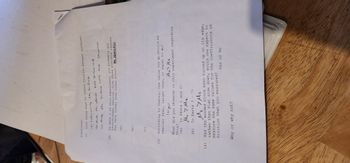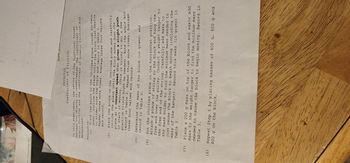
College Physics
11th Edition
ISBN: 9781305952300
Author: Raymond A. Serway, Chris Vuille
Publisher: Cengage Learning
expand_more
expand_more
format_list_bulleted
Concept explainers
Question
Need question 2 and question 4

Transcribed Image Text:Questions:
(1) List three ways to reduce friction between surfaces:
(a) lubricting the surface.
(b) make the object
(c) Make the surfaces little
(4)
(a)
(b)
(2) In Part 1 of this experiment, you probably got
inconsistent results. Give three possible reasons
(other than human error). Be specific.
for this
(c)
More Streamlined
(3) According to theory, the value for us should be
smaller than, larger than, or equal to Mk?
мумк
mer
(a) In Parts 1 and 2:
Ms 7 Mx
Smoother
larger
What did you observe in this experiment regarding
this?
(b)
Why or why not?
In Parts 3 - 7:
Мк умс
Had the wooded block been turned up on its edge,
rather than flat side down, would one expect to
measure the same values for the coefficients of
friction that you measured?
Yes or No
*******************

Transcribed Image Text:Name
PHYS202L
Coefficient of Friction
In this experiment, the nature of the frictional forces
between two objects is investigated. The coefficient of
static friction and the coefficient of kinetic friction are
determined.
Procedure:
(1) Place the block on the inclined plane (large surface
down). Incline the plane until the block just begins
to slide; note the angle and record in Table 1.
Repeat three more times. Average these four values
and record.
(2) Place the block on the inclined plane and carefully
incline the plane until the block moves down the
plane at a constant speed when given a slight push
to start it moving. (This is tricky to do; a few
practice trials might be needed). Note the angle and
record in Table 2. Repeat three more times. Average
these four values and record.
(3) Determine the mass of the block (in grams) and
record in Table 3.
(4) Put the inclined plane in the horizontal position.
Attach a piece of string to the block and hang the
free end over the pulley. Connect a weight hanger to
the free end of the string. Carefully add mass to
the mass holder to find the minimum mass needed to
just cause the block to begin moving (including the
Table 3. u
mass of the hanger). Record this mass (in grams) in
(5) Place a 200 g mass on top of the block and again add
mass to the weight hanger to find the minimum mass
needed to cause the block to begin moving. Record in
Table 3.
800 g on the block.
(6) Repeat Step 5 by placing masses of 400 g, 600 g and
Expert Solution
arrow_forward
Step 1
When there is a relative motion or tendency of relative motion between two rough surfaces then friction force comes in to existence. Friction may support a motion or oppose a motion but it always opposes relative motion. Friction forces are of two type :
1. Static friction : When there is tendency of relative motion but no actual relative motion between the surfaces then the friction force between the surfaces is called static friction force.
2. Kinetic friction : When there is a relative motion between the surfaces, kinetic friction works between the surfaces.
Trending nowThis is a popular solution!
Step by stepSolved in 3 steps

Knowledge Booster
Learn more about
Need a deep-dive on the concept behind this application? Look no further. Learn more about this topic, physics and related others by exploring similar questions and additional content below.Similar questions
- The mass of a certain elephant is 4,867 kg. (a) Find the elephant's weight in newtons. N(b) Find its weight in pounds. lbarrow_forwardA car travels at 43 km/hr for 1 hour. It in travels in addition of distance of 20 KM in four hours. The average speed of the car for the entire trip is (in, km, hr)arrow_forwardIf your mass is 79.62 kg, what is your weight in newtons?arrow_forward
arrow_back_ios
arrow_forward_ios
Recommended textbooks for you
 College PhysicsPhysicsISBN:9781305952300Author:Raymond A. Serway, Chris VuillePublisher:Cengage Learning
College PhysicsPhysicsISBN:9781305952300Author:Raymond A. Serway, Chris VuillePublisher:Cengage Learning University Physics (14th Edition)PhysicsISBN:9780133969290Author:Hugh D. Young, Roger A. FreedmanPublisher:PEARSON
University Physics (14th Edition)PhysicsISBN:9780133969290Author:Hugh D. Young, Roger A. FreedmanPublisher:PEARSON Introduction To Quantum MechanicsPhysicsISBN:9781107189638Author:Griffiths, David J., Schroeter, Darrell F.Publisher:Cambridge University Press
Introduction To Quantum MechanicsPhysicsISBN:9781107189638Author:Griffiths, David J., Schroeter, Darrell F.Publisher:Cambridge University Press Physics for Scientists and EngineersPhysicsISBN:9781337553278Author:Raymond A. Serway, John W. JewettPublisher:Cengage Learning
Physics for Scientists and EngineersPhysicsISBN:9781337553278Author:Raymond A. Serway, John W. JewettPublisher:Cengage Learning Lecture- Tutorials for Introductory AstronomyPhysicsISBN:9780321820464Author:Edward E. Prather, Tim P. Slater, Jeff P. Adams, Gina BrissendenPublisher:Addison-Wesley
Lecture- Tutorials for Introductory AstronomyPhysicsISBN:9780321820464Author:Edward E. Prather, Tim P. Slater, Jeff P. Adams, Gina BrissendenPublisher:Addison-Wesley College Physics: A Strategic Approach (4th Editio...PhysicsISBN:9780134609034Author:Randall D. Knight (Professor Emeritus), Brian Jones, Stuart FieldPublisher:PEARSON
College Physics: A Strategic Approach (4th Editio...PhysicsISBN:9780134609034Author:Randall D. Knight (Professor Emeritus), Brian Jones, Stuart FieldPublisher:PEARSON

College Physics
Physics
ISBN:9781305952300
Author:Raymond A. Serway, Chris Vuille
Publisher:Cengage Learning

University Physics (14th Edition)
Physics
ISBN:9780133969290
Author:Hugh D. Young, Roger A. Freedman
Publisher:PEARSON

Introduction To Quantum Mechanics
Physics
ISBN:9781107189638
Author:Griffiths, David J., Schroeter, Darrell F.
Publisher:Cambridge University Press

Physics for Scientists and Engineers
Physics
ISBN:9781337553278
Author:Raymond A. Serway, John W. Jewett
Publisher:Cengage Learning

Lecture- Tutorials for Introductory Astronomy
Physics
ISBN:9780321820464
Author:Edward E. Prather, Tim P. Slater, Jeff P. Adams, Gina Brissenden
Publisher:Addison-Wesley

College Physics: A Strategic Approach (4th Editio...
Physics
ISBN:9780134609034
Author:Randall D. Knight (Professor Emeritus), Brian Jones, Stuart Field
Publisher:PEARSON